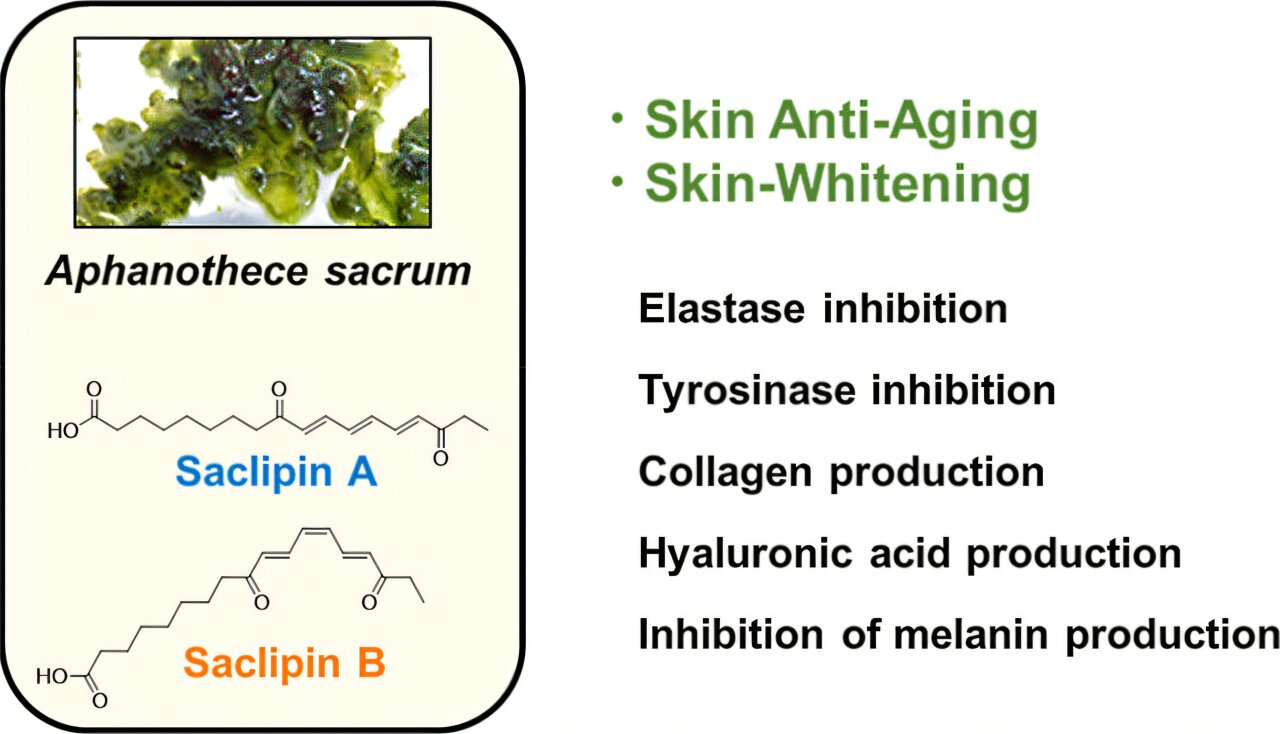Cyanobacteria, or blue-green algae, have existed for billions of years, adapting to a diverse range of environments. Their remarkable ability to photosynthesize and make their own food, as well as their adaptability across a variety of habitats, make them a subject of focus for the research fraternity.
One such cyanobacterium native to Japan—Aphanothece sacrum, also known as Suizenji-nori—has been extensively studied for its bioactive properties and potential health benefits. Notably, A. sacrum accumulates natural compounds known as saclipins A and B in response to drought stress. These compounds are significant due to their ability to absorb ultraviolet (UV)-A and UV-B rays, making them potential skin-protective agents.
In 2023, Professor Hakuto Kageyama, Dean of the Graduate School of Environmental and Human Sciences at Meijo University, Japan, along with his colleagues, discovered saclipins in A. sacrum. Their research paper highlighted the unique characteristics of saclipins, such as UV-absorbing capacity and anti-aging properties like antioxidative and antiglycative activities.
Prof. Kageyama states, “This unique characteristic makes saclipins ideal for use in skin application or as an oral supplement. Moreover, this finding inspired me to explore additional activities of saclipins that can be applied in the skincare and cosmetic industry.”
Based on their initial findings, Prof. Kageyama, along with Yoshie Uchida and Masaki Honda from Meijo University and Rungaroon Waditee-Sirisattha, from Chulalongkorn University, Thailand, carried out further study in 2024 to assess the anti-aging properties of the saclipins. This study was published in ACS Agricultural Science & Technology.
In this study, the researchers dried and powdered A. sacrum to extract saclipins and tested it for its anti-aging properties. The researchers investigated the chemical properties of saclipins by examining their stability under light and heat conditions. Next, they tested the scavenging activity of singlet oxygen to analyze the antioxidant potential and physiological effect on skin health.
“We examined how saclipins affect skin-related processes such as elastase inhibition and the production of collagen and hyaluronic acid, which contribute to skin firmness and moisture,” explains Prof. Kageyama.
In addition, the study also assessed the tyrosinase inhibitory activity of saclipins. Tyrosinase plays a crucial role in melanin production and contributes to skin pigmentation.
Researchers observed that saclipins had strong inhibitory activity against elastase and promoted the production of collagen and hyaluronic acid in human skin fibroblasts. These results indicate that saclipins have the effect of improving skin quality. In addition, saclipins inhibited tyrosinase and suppressed melanin production in mouse B16 melanoma cells.
The team used both purified saclipins A and B as well as saclipin-containing extracts prepared from dried A. sacrum for evaluation. The results demonstrated that the extracts showed similar activity compared to the fresh ones.
Prof. Kageyama says, “The extracts also had an equal or increased activity than the purified ones, which suggests an easier formulation and cheaper manufacturing, making it a viable option for skincare products.”
As is well known, skin aging is a prevalent concern worldwide and has boosted the global market for skincare products.
“The growing demand for endangered A. sacrum and the discovery of saclipins may also encourage its large-scale production, rejuvenating the aquaculture industry, promoting conservation efforts, and preventing its extinction,” adds Prof. Kageyama.
These findings thus provide valuable insights into the role of saclipins as an anti-aging formula found in the edible cyanobacterium A. sacrum, alongside its other known beneficial activities.
More information:
Yoshie Uchida et al, Photo- and Thermo-Chemical Properties and Biological Activities of Saclipins, UV-Absorbing Compounds Derived from the Cyanobacterium Aphanothece sacrum, ACS Agricultural Science & Technology (2024). DOI: 10.1021/acsagscitech.4c00571
Provided by
Meijo University
Citation:
Natural substance from edible cyanobacterium could combat skin aging by enhancing collagen (2024, November 22)
retrieved 22 November 2024
from https://phys.org/news/2024-11-natural-substance-edible-cyanobacterium-combat.html
This document is subject to copyright. Apart from any fair dealing for the purpose of private study or research, no
part may be reproduced without the written permission. The content is provided for information purposes only.


